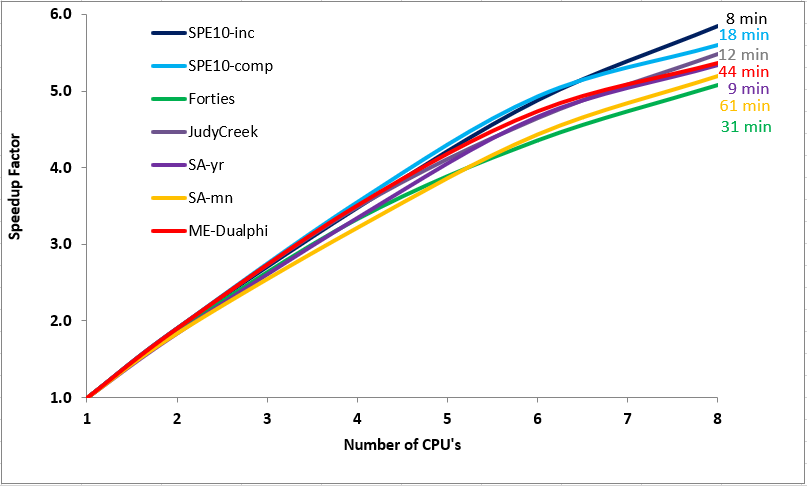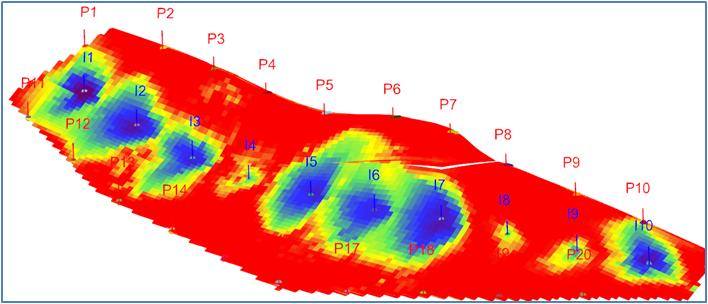3DSL Features
Standard Features
- Fully three-dimensional including gravity
- Corner point, structural, or strict Cartesian grids with active/inactive blocks
- Multiple relperm regions w/ relperm scaling
- Multiple 3-phase relperm models
- Well control - (historical) surface or reservoir individual phase and total rate constraints
- Vertical, horizontal, and deviated wells with time dependent recompletions
- Well rate allocation factors - how much support each injector is giving to each producer
- Well drainage volumes - reservoir fluid volumes contacted by each well
- Standard grid and well outputs and output of streamline paths (all viewable during runtime)
- Simple, keyword-driven input deck
- 32/64 bit support on Windows and Linux
- Import velocity field from Eclipse models and then trace SL's and extract SL-based metrics
- 3DSL® can read/write ECLIPSE formatted files for support within 3rd party software
Surveillance
Surveillance is included in the 3DSL_base license.
- SURVEILLANCE=ON keyword only allowed
- No transport step along streamlines.
- Pattern material balance calculations for fluid-in-place calculations.
- Compressible or Incompressible PVT
- Forecasting of existing wells, new wells, and well conversions using correlations of historical well responses to properties of well-drainage volumes.
PVT Models
The PVT models in 3DSL® account for two key features: (1) compressibility (pressure effects) and (2) miscibility (composition effects), with no dependence on temperature. While all real systems exhibit compressibility (the downhole volume differs from its surface volume) and miscibility (components mixing in different phases), engineering practice often assumes incompressibility and immiscibility initially. When applied correctly, these assumptions can provide excellent results.
In complex system modeling, there is always a tradeoff between the accuracy of the physics and the speed of the simulation. In 3DSL, simpler flow physics result in faster simulations, with the single-phase model (MODEL=SINGLEPHASE), also known as the Tracer model, being the fastest and the Blackoil model the slowest. Determining the right balance between physical detail and simulation speed depends on the specific problem. As a general best practice, it is recommended to begin with a simpler physical model and add complexity incrementally as needed.
Incompressible or Compressible. In streamline-based simulation, the assumption of incompressibility can significantly improve simulation speed, making it worthwhile to convert a compressible model into an "equivalent" incompressible model. Typically, when the flow behavior being studied is primarily influenced by system geology—such as predicting where and how quickly injected water will break through at producer wells—compressibility has a second-order effect and can often be ignored in the initial stages of a study.
It is important to note that compressibility only describes how phase densities change with pressure. It says nothing about how phase compositions change with pressure. Incorporating compressibility into 3DSL® introduces a computational overhead, as the solution becomes dependent on the system's absolute pressure level that may need more frequent updating.
The inclusion of compressibility marks a significant advancement in streamline-based simulation, as streamlines have traditionally assumed incompressibility of both fluids and rock.
Miscibility. 3DSL® has three models for miscibility: (1) completely immiscible flow, (2) first-contact miscible flow, and (3) the standard Blackoil model.
Completely immiscible flow is the standard "waterflood" model, where the water phase consists of 100% water component, the oil phase is composed of 100% oil component, and gas phase consists of 100% gas component. Components never mix, regardless of pressure.
In first-contact miscible flow (MODEL=FCM), it is assumed that gas (or solvent) can dissolve into both the oil and water phases, with the extent of dissolution dependent on the compositions of these phases. As a result, phase densities and viscosities will change based on the amount of gas (or solvent) dissolved in each phase.
The Blackoil model is the standard "Rs" model, where the amount of gas dissolved in the oil is determined as a function of reservoir pressure. Rs represents a ratio of dissolved gas produced for a given volume of oil produced and where the ratio is given at standard conditions. Since Rs is pressure-dependent, the Blackoil model is only applicable for compressible systems.
Immiscible Model. The immiscible model assumes immiscibility of the phases but each phase (and rock region) can have its own relative permeability functions. Additionally, phase densities and viscosities may vary with pressure, making the system compressible. Immiscible models are nonlinear and as a result, streamlines will change not only because of changing well events but also due to density differences (gravity) and non-unit mobility ratios (viscosities and relative permeabilities).
Miscible Model. The degree of miscibility—how much gas component dissolves into the oleic phase (and/or water phase)—is governed by a parameter, omega (ω). If ω = 1, all the gas resides in the oleic phase, creating a two-phase system (oleic + water). If ω = 0, all the gas remains in the gas phase, reverting the system to a traditional three-phase (oil, gas, water) immiscible model. For ω values between 0 and 1, the system remains three-phase (oleic, gas, water), but the gas saturation is lower than in a purely immiscible model due to partial dissolution into the oleic phase.
The value of ω is influenced by the total oil and gas mass fractions within a grid cell. The amount of gas that can dissolve into the oil phase also depends on the amount of oil present. Alternatively, a maximum solubility can be defined. Consult the technical appendix of the 3DSL® manual for a comprehensive explanation of the model and its equations.
Blackoil Model. 3DSL's® Blackoil model is a standard implementation commonly found in many finite-difference simulators. It incorporates compressibility, enabling gas to either come out of solution or dissolve into the oil depending on the system's pressure and the amount of gas present.
Dual-Porosity Option
- Dual-porosity (3dsl_dualphi license)
Parallel Option
3DSL® has a parallel compute option that is automatically activated if a 3dsl_parallel license is found. The parallel license puts no restrictions on the number of cores used by 3DSL®--this is user defined --during a run, meaning that running a 3DSL® deck on 2,4,8,16, or more cores always uses a single 3dsl_base license and a single 3dsl_parallel license. The parallel license is part of the Surveillance and Simulation Base packages.
However, how much faster 3DSL® will be when running on multiple cores it is not as simple as doubling CPU's will double speedup. The maximum speedup is related to the overall fraction of parallelized runtime code. Depending on your model physics, number of gridblocks, number of timesteps, and timestep size, determines the fraction of parallelized runtime code. See the chart below to give you a guide as to the speedup performance of 3DSL® as you add cores. Note that the greatest incremental gain in speedup is for a low number of CPU's. Regardless of model type, you can expect at least a 1.5X speedup in run time just by running 3DSL® on a dual-core system. But after about 6 cores, incremental speed gains deminish.

- SPE10-inc. Incompressible 2-phase. 1.1 million active grid cells, 25 timesteps over 2000 days.
- SPE10-comp. Compressible deadoil. 1.1 million active gridcells, 27 timesteps over 2000 days.
- Forties. Incompressible 2-phase. 1.5 million active grid cells, 235 wells, 82 timesteps over 34 years.
- JudyCreek. Incompressible 3-phase FCM. 623,000 active grid cells, 300 wells, 46 timesteps over 40 years.
- SA-yearly. Compressible deadoil, 970,000 active grid cells, 25 wells, aquifer, 24 timesteps over 24 years. SA-monthly is the same run but with 288 timesteps.
- ME-Dualphi. Incompressible, 706,000 active grid cells, dualporosity, 145 producers, 60 timesteps over 34 years.
Chemical Option

The polymer/surfactant flooding option in 3DSL® allows modeling of polymers and/or surfactants in the water-phase. The feature is part of the general chemical module that allows to include any number of inert tracers or reactive polymers in the water phase. The chemical module is an add-on item to 3DSL® and is part of the "Simulation All" package.
Polymer flow physics includes the effect of increasing water viscosity with increasing polymer concentration, shear-thinning effects, reversible adsorption, dependence on salt concentration, and permeability reduction. See SPE paper 115545 for technical details on extending streamlines to polymer floods as well as validation with Eclipse. See SPE paper 132774 for a reservoir management workflow to optimize a polymer flood using streamline-base polymer metrics. The application to a polymer flood in operation since early 2010 in the Sultanate of Oman is described in SPE paper 169746. Modeling surfactant flooding using streamlines is described in SPE paper 170106.

